6 Major Ports in Finland
Finland is a prosperous economy with a strong manufacturing sector. The Nordic country has flourishing foreign trade resting on a well-developed network of ports and harbours located near the mouths of either the Gulf of Finland or the Gulf of Bothnia.
It has significant forest and freshwater resources which makes it a leading exporter of timber and forest products followed by chemicals, electronics, machine equipment, automobiles and minerals.
Finland has trade relations with Germany, the Netherlands, the United States, Russia, Sweden and China.
Let’s take a look at some of the major ports of Finland.
Port of Helsinki
Helsinki port is situated on the southern Finnish coastline at the mouth of the Vantaa river near the Gulf of Finland. Its strategic geographical location makes it the major seaport of Finland, with direct maritime connections to neighbouring countries like Russia while it has major trade relations with Germany, Britain, Denmark, Sweden, Estonia. It imports consumer products, raw materials and industrial products while the port’s major export items are forest goods, metals, textiles and glassware.
Helsinki is also the biggest commercial and passenger port, possessing the largest container handling facility in Finland. Approximately 8,750 vessels and 10,210,000 tonnes of cargo, including 405,000 TEU and 10,000 passengers are handled at the port annually.
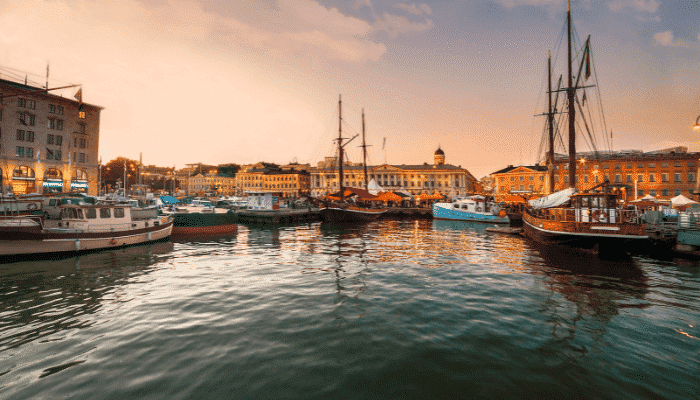
More than 50% of Finnish imports are received at Helsinki harbour located amidst Finland’s main industrial zone housing textiles, print, metal processing and chemical industries. The port city is popular for manufacturers such as Arabian style porcelain, while the shipbuilding industry also offers considerable employment to the local population. The port consists of four main port areas covering 165 hectares with a total quay length of 11,050 m, designated for handling specific cargoes.
West port has three berths for handling containers and passenger ships while the North Harbour witnesses less cargo traffic as the majority of maritime trade is now conducted from the Vuosaari port and its container terminal.
Vuosaari Port
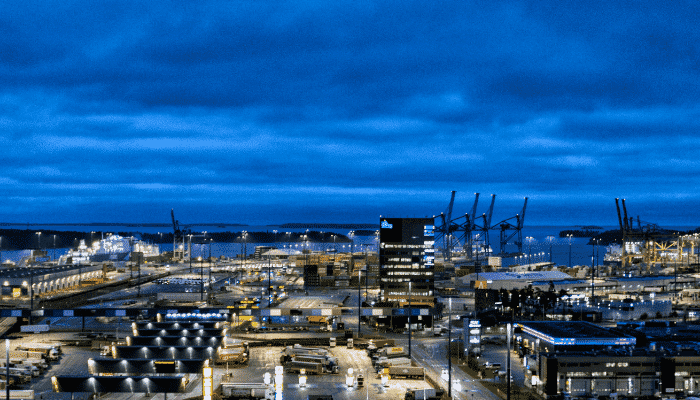
This facility handles one-third of the Finnish containerised cargo and Roro. Located a few kilometres from the main port area, it also provides storage and customs services. Covering 121 hectares, this terminal incorporates space for handling dangerous goods, and 50 reefer connections. Its Finnsteve terminal has a maximum capacity of accommodating 5000 TEU. Equipped with 180 reefer points in its 2-hectare warehouse, it also has a container facility including a 3-hectare space dedicated for container stuffing. Adjacent to this is an open yard for keeping empty containers and packed timber.
Vuosaari container terminal
The main container handling facility of Helsinki port, it can deal with shipments of 4000 TEUs and 150,000 trailers. Its multi-link facilities covering 5 hectares can accommodate 4140 TEUs, offering reefer plugs for 90 containers at once.
Southern Port
The Southern port’s facilities are leased to the prominent Finnish shipping company, Viking Line ABP which operates cruises and ferries since Helsinki is also the busiest passenger port in the country. The South port has numerous berths for handling cruises and yachts destined to Tallinn, Stockholm, Rostock, Travemunde etc. In summers the southern port is visited by more than 290 cruises carrying around 350,000 people.
Port of Hamina
Hamina port lies on the coast of the Gulf of Finland and is the closest Finnish port to the Russian border, hence its major trade partner is Russia. It also indulges in regular trade with major European and North American ports. Hamina is Finland’s biggest export facility serving the forest industry by transporting paper, boards, pulp, plywood and sawn timber. It has several multipurpose docks stretching more than 3 kilometres with direct rail connections to the Far East and the country’s hinterland.
A multifunctional port, it handles general cargo, dry cargo, containers and liquid bulk such as oil, liquified petroleum gas and hazardous chemicals. Around 4,520,000 tonnes of cargo, 210,000 TEU and 1,000 ships are handled at this port annually. It can accommodate the biggest ships and carriers with a maximum draught of 12 m.
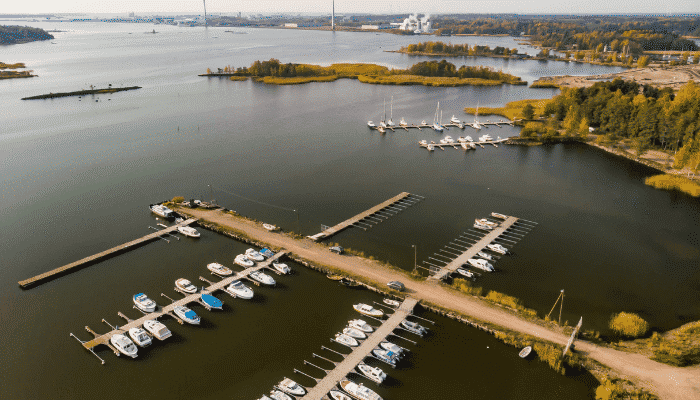
Counted among the top 5 biggest ports of the country, Hamina is owned by the local government and operated by the Port of Hamina Ltd, which is responsible for port operations. Apart from forest goods, it also handles significant roro cargo on its two dedicated berths with seven inbuilt ramps.
Container terminal
The port’s container facility is one of the most efficient in the entire region comprising three container wharves with a total berth length covering 700 m and endowed with modern equipment such as 6 mobile cranes, 8 shore cranes, trans stainers, and 10 forklifts.
The port’s Hillo berth covers 310 m with a depth of 6 m and handles general cargo while the Lakulahti pier measures 805 m and has a water depth ranging from 8 to 8.5 m for handling timber and wood logs. Hirenkari wharf stretches 450 m and deals with shipments of bulk cargoes.
Oil Handling facility
The port’s oil terminal incorporates three docks spanning 250 m, for accommodating oil tankers. It has 450,000 sq m of storage space and 10 storage tanks with a capacity to keep more than 850,000 m3 of oil and petroleum derivatives. It also has an additional 150 m long berth for handling only LPG.
Port of Kokkola
Kokkola port, alternatively called Ykspihlaja is the third-largest general cargo port in Finland. A medium-sized port, it has one of the deepest waters and can accommodate ships weighing more than 100,000 DWT with a draft of 13 m and an LOA of 100 m. It lies on the eastern coastline of the Gulf of Bothnia opening to the Baltic Sea.
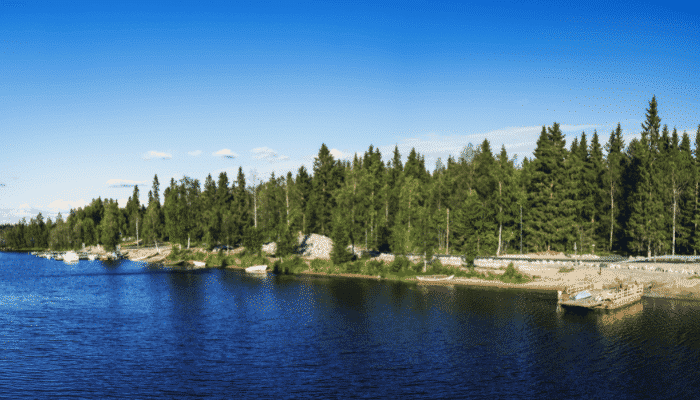
The port city is the capital of the central Finnish region called Ostrobothnia, which is also an industrial centre, well- known for its chemical industry. Divided into three port areas, Kokkola specialises in dealing with shipments of dry cargo, bulk, chemicals, pyrites and timber. It also receives transit cargoes of zinc concentrates, oil, iron pellets, limestone destined to Russia. Kokkola port also deals with liquid bulk and 1 million tonnes of petroleum goods, oils and acids are shipped through this facility.
One of the busiest Finnish ports, around 650 ships and 7,000,000 tonnes of cargo passes through it every year.
The Deepwater harbour
The deep harbour of the Kokkola port comprises 26 berths stretching 1270 m, for handling bulk cargoes like iron pellets, coal, iron oxide etc. This facility handles more than 65% of the port’s cargo since it is well equipped with modern port technologies, fully-functional equipment and Finland’s one and only Rail Wagon Tippler Terminal. It can accommodate Capesize and Panamax size ships. Since the port’s fairway was deepened in 2020, it allows the loading of the biggest ships to their maximum carrying capacities, therefore decreasing freight costs.
This port underwent an expansion in recent years which resulted in the construction of an additional 35,000 sq m of warehouse space, acquisition of 8 new cranes, and installation of an efficient conveyor belt system for faster loading and unloading of bulk carriers.
General Cargo Port
Kokkolo’s general port has 5 wharves covering 692 m with depths from 5 to 9.5 m respectively. This facility handles bagged cargoes such as sawn timber, poles, spars etc. Roughly 450,000 m3 of timber is shipped from this port annually. It also has 40,000 sq m of warehouse space for keeping conventional cargo.
This port also houses Europe’s biggest All-weather Container terminal, the only facility in the Nordic region that handles the majority of containerised goods. This terminal can accommodate ships weighing more than 10,000 DWT.
Silverstone Harbour
This is a recent facility that was built for handling light bulk and project lifts. Clean bulk such as alumina, limestone are handled at this harbour which comprises 3 quays with a total length of 320 m. The port has three Gottwald harbour cranes with a lifting capacity of 140 tonnes.
Port of Pori
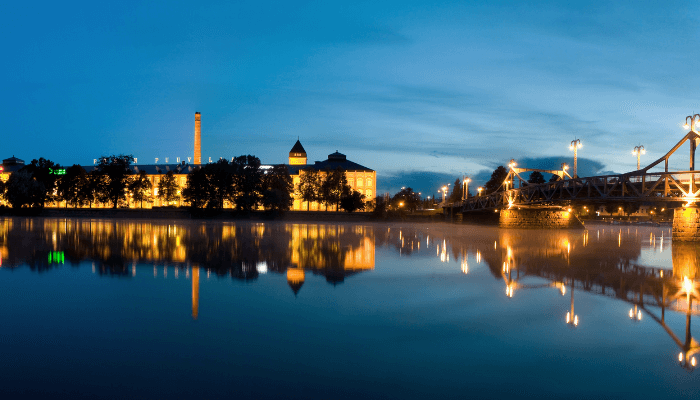
The pori deep water port lies on Finland’s western coastline near the Gulf of Bothnia and incorporates three harbours with a total quay length of 2300 m and a draught of 10 m that handle more than 5,650, 500 tonnes of cargo annually. These facilities can accommodate ships with an LOA of 180 m and a draught of 10 m. About one-third of Finnish sawn timber goods are exported from pori port. The port is being expanded and a new Roro ramp was constructed in 2019 for accommodating the increasing Roro traffic. Having a draught of 10 m, it would allow larger vehicle carriers to berth at the port.
The port has the latest and most powerful cranes with a lifting capacity ranging from 150 to 300 tonnes including an LHM 550 crane which was acquired in 2020. It also has several forklifts, a stacking conveyor and 2 loaders.
Mantyluoto terminal
Situated in the southern port area, it deals with container goods, dry cargo, liquid bulk, project cargo, roro and breakbulk. It uses the services of icebreaker vessels during winters hence it is navigable throughout the year. Mantyluoto harbour also possesses Finland’s biggest crane known as Masa with a maximum lifting capacity of 200 tonnes.
The Reposaari harbour is the country’s biggest coal handling facility that feeds 2 coal power plants and also deals with shipments of oil and minerals. It has an additional wharf for accommodating recreational vessels and a trawler berth too.
Tahkoluoto sub-port has a 15 m water depth that allows the Panamax size ships to berth at the facility. One of the deepest Finnish ports, Tahkluoto handles general cargo and liquid bulk. The port has 4 berths stretching more than 500 m serving bulk carriers and oil tankers with a maximum draught of 15 m. With a loading capacity of 1250 tonnes per hour, it is well equipped with the versatile and latest equipment for handling diverse cargoes.
The port has a separate chemical and oil handling facility for handling oil, fuels, petroleum and LPG. Due to increasing liquid cargoes, a new wharf for handling chemicals was being constructed at the Tahkoluoto oil terminal. The 280 m long and 12 m berth is said to be completed by the end of this year.
Port of Rauma
Rauma port is situated on Finland’s southwestern coast just 200 kilometres from the capital Helsinki. It handles shipments of oils, chemicals, Roro, container goods and general cargoes. The main export commodities of Rauma include chemicals and forest products while it receives considerable amounts of china clay. An ice-free facility, it is visited by 1290 ships and handles 5,610,000 tonnes of cargo and 166,000 TEU every year.
Rauma also ranks as Finland’s fifth-biggest port, the port city being renowned for its exquisite lace goods. In 1991, the old city was declared by UNESCO as a world heritage site. The port attained importance after the second world war when it was gradually transformed into an industrial hub containing ship construction, paper and metal industries. It also boasts of being the biggest paper exporting port in Finland, shipping around 3 million tonnes of paper and cardboard annually.
It incorporates 20 berths covering 115 hectares along with a general cargo storage area spanning 260,000 sq m, 29,000 sq m of warehouse space and 6 sheltered yards for storing bulk cargo. Two silos in the eastern port area with a storage capacity of 550,000 sq m are utilised for storing chemicals.
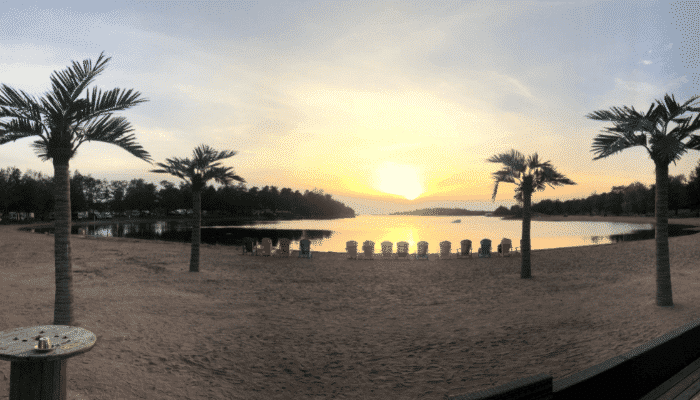
The port also has one of the most expansive Finnish container handling facilities covering 18 hectares with five wharves. The Oil harbour situated near this terminal has three berths for accommodating oil tankers weighing more than 50,000 DWT.
Apart from being a cargo port, Rauma is also a prominent tourist attraction. It handles more than 10,000 travellers on its passenger berth. Mostly visited during the summer months, many people visit this beautiful port city for experiencing its rich architectural heritage and for attending the Lace week which is a cultural celebration.
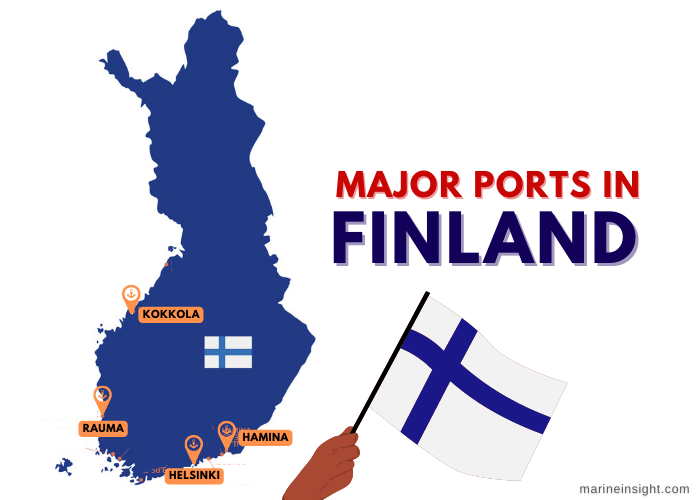
You might also like to read:
- 10 Major Ports in Europe
- 10 Major Ports In Germany
- Top 14 Major Ports in Italy
- 12 Major Ports Of Norway
- 2 Major Ports in Monaco
Disclaimer :
The information contained in this website is for general information purposes only. While we endeavour to keep the information up to date and correct, we make no representations or warranties of any kind, express or implied, about the completeness, accuracy, reliability, suitability or availability with respect to the website or the information, products, services, or related graphics contained on the website for any purpose. Any reliance you place on such information is therefore strictly at your own risk.
In no event will we be liable for any loss or damage including without limitation, indirect or consequential loss or damage, or any loss or damage whatsoever arising from loss of data or profits arising out of, or in connection with, the use of this website.
Do you have info to share with us ? Suggest a correction
Disclaimer :
The information contained in this website is for general information purposes only. While we endeavour to keep the information up to date and correct, we make no representations or warranties of any kind, express or implied, about the completeness, accuracy, reliability, suitability or availability with respect to the website or the information, products, services, or related graphics contained on the website for any purpose. Any reliance you place on such information is therefore strictly at your own risk.
In no event will we be liable for any loss or damage including without limitation, indirect or consequential loss or damage, or any loss or damage whatsoever arising from loss of data or profits arising out of, or in connection with, the use of this website.
Latest Maritime Knowledge Articles You Would Like:
Subscribe To Our Newsletters
By subscribing, you agree to our Privacy Policy and may receive occasional deal communications; you can unsubscribe anytime.















